“What if something as simple as the background music in a store or the color of a button on a website could influence what you buy?” This question highlights the heart of priming in marketing—small cues that can shape consumer behavior without people consciously noticing. This concept might seem close to mind control, but it is rooted in well-documented psychological phenomena.
Priming involves exposing people to certain stimuli—words, images, sounds, or other subtle environmental factors—to influence how they subsequently feel or act. These influences often happen at a subconscious level, nudging customers toward specific choices or attitudes in ways that can be surprisingly powerful.
From a marketing standpoint, priming is about setting the stage for consumers to engage with your message, product, or service in a desired way. A slight change in your background music, color palette, or phrasing can have a measurable effect on consumer behavior. Used ethically, priming in marketing has become a staple for creating more persuasive and supportive environments that encourage positive brand experiences and guide purchasing decisions.
This article explores what priming is, how it works in the brain, and real-world examples of priming’s effects on behavior—from the kind of music that influences which type of wine a shopper buys to the subtle color changes that might nudge an online visitor toward a purchase. The sections that follow also offer practical strategies on using priming in marketing communications, visual design, copywriting, and more.
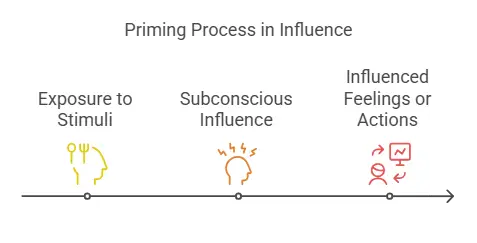
What Is Priming?
Priming is a psychological phenomenon where exposure to one stimulus influences the response to a subsequent stimulus, often without conscious awareness. It operates on the principle that our brains form associations between different ideas and experiences. When a concept is activated—whether through a word, image, sound, or scent—it makes related ideas more accessible, subtly shaping perceptions and behaviors. This process occurs continuously in everyday life, from the way we interpret a conversation to how we decide on a product purchase.
In marketing, priming is harnessed to nudge consumers toward desired actions. By carefully selecting stimuli such as background music, color schemes, or specific language in advertising, marketers can create an environment that subconsciously influences customer decisions. For example, warm colors and soft lighting may prime feelings of comfort and trust, while urgent phrases like “limited time” can create a sense of scarcity and prompt immediate action. This influence is subtle; consumers rarely recognize the cue, yet it significantly shapes their behavior.
The power of priming lies in its ability to establish a mental context that aligns with a brand’s messaging without overt persuasion. Understanding how priming works enables businesses to design campaigns and environments that resonate on a deeper, emotional level. In essence, effective priming can lead to a cohesive brand experience where every sensory detail contributes to influencing consumer behavior—enhancing engagement and ultimately driving conversions.
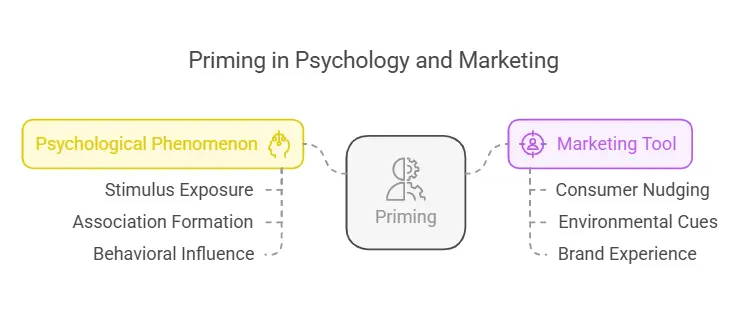
Defining Priming in Marketing Psychology
“Priming in marketing” refers to techniques where initial stimuli—often unnoticed or barely noticeable—affect how people respond to subsequent information. These stimuli can be environmental (like store ambiance), auditory (like background music), visual (like product imagery), or even linguistic (like specific words in ad copy). By consciously choosing the cues that consumers encounter, marketers can shape perceptions and influence buying decisions in subtle but effective ways.
This concept is grounded in the cognitive principle that our brains build associations. When we hear, see, or experience something related to a concept, our subconscious mind “activates” that concept. As a result, future decisions might align with these activated ideas, even if we’re not consciously aware of it.
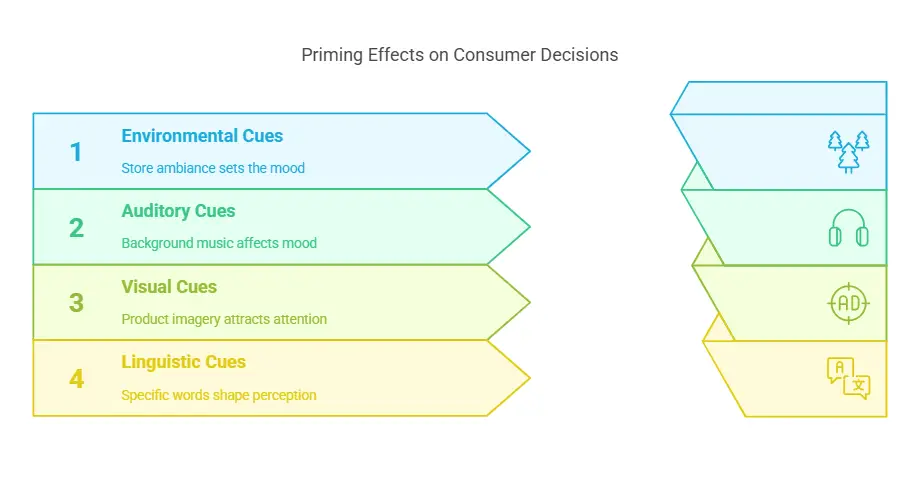
The Cognitive Basis: How Priming Works
Our minds link ideas constantly. If you read about winter, images of snow, cold weather, and the holidays may pop up. If you see an ad full of tropical imagery, you might start thinking about warmth, beaches, and relaxation. This priming in marketing effect on consumers occurs because we carry an extensive network of mental associations. When one node in that network is triggered, related concepts become more accessible.
In one famous psychology experiment, participants who read words associated with old age (like “Florida” and “bingo”) walked more slowly afterward—an unconscious response to the activated concepts of aging. Translating this to the realm of marketing, a simple piece of background music or a cleverly chosen image can make a person more inclined to behave in a way that aligns with the activated concept.
Types of Priming in Consumer Behavior
- Semantic Priming: Involves words or ideas. For instance, using synonyms or related phrases in an ad can make certain themes (like “freshness” or “luxury”) top of mind.
- Visual Priming: Based on images or designs that trigger emotions or memories. Colors, shapes, and even subtle patterns can set the tone for how consumers interpret a brand.
- Auditory Priming: Background sounds, music tempo, or specific jingles can guide mood and behavior.
- Environmental Priming: The overall ambiance—store layout, scent, temperature—creates associations that influence consumer responses.
- Social Priming: Cues that trigger norms or social rules. Displaying imagery of eyes in a space can subtly encourage honesty or make people feel watched, potentially changing their behavior.
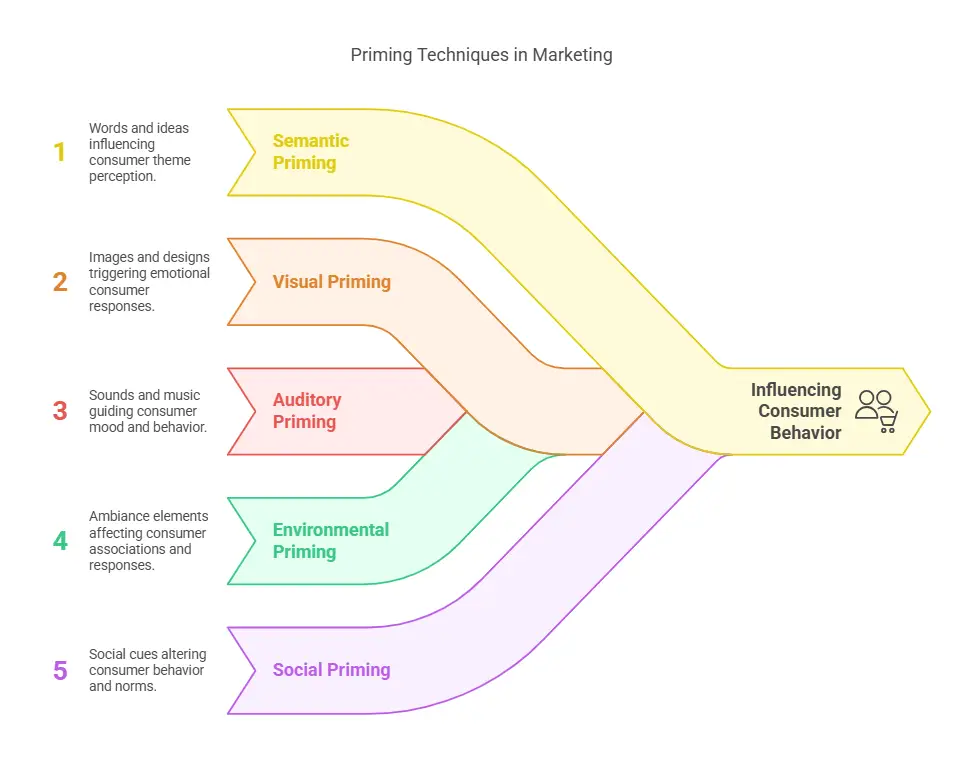
A Classic Example: The Wine Store Study
An often-cited study had a wine store alternate between French music and German music. On days with French music, French wine sales spiked; on days with German music, German wine sales took the lead. Customers consistently overlooked the music’s role in their choices, yet it primed them toward certain cultural associations and buying decisions.
Another Compelling Example: The “Eyes” Study
In another study, researchers placed an image of eyes near an honesty box for coffee donations. People contributed more when they felt (subconsciously) watched, even though it was just an image. This highlights how simply seeing eyes can prime us to adhere more strongly to social norms of honesty.
Using priming psychology marketing effectively means harnessing these kinds of insights ethically—aiming to add value or improve the consumer experience, rather than trick or deceive.
Examples of Priming in Consumer Contexts
Music and Atmosphere
Music in a retail setting goes beyond mere decoration. Slow, softer music tends to encourage customers to linger, often leading to higher spending. In supermarkets, this ambient influence on consumer behavior can translate to shoppers filling their carts with more items. Meanwhile, faster, upbeat music in quick-service restaurants might keep people moving—ideal if the business wants a higher turnover of tables.
For luxury retailers, classical music can prime sophistication and openness to spending more. One study found that when classical music played in a wine shop, customers were more likely to purchase premium bottles, linking elegance and class to a higher willingness to pay.
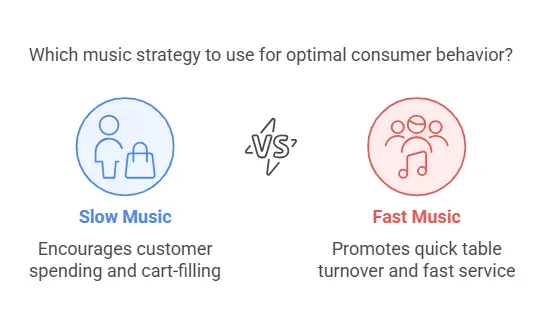
Color and Décor
Color is among the most effective tools for subconscious cues in marketing. The overall color scheme of a store or a website can prime how consumers feel:
- Cool Blues and Greens: Often prime calmness, trust, and a sense of freshness. Many health and wellness brands lean on these shades.
- Warm Reds and Oranges: Can prime excitement, urgency, or appetites. Think of how fast-food branding often incorporates red or yellow.
- Luxury Golds and Blacks: Prime feelings of premium, exclusive, or high-end experiences.
Décor also matters. An electronics store might use modern lighting or sleek minimalism to prime a “tech-savvy” mindset. A home goods store might use softer, cozier lighting and plush seats to prime comfort and familial warmth.
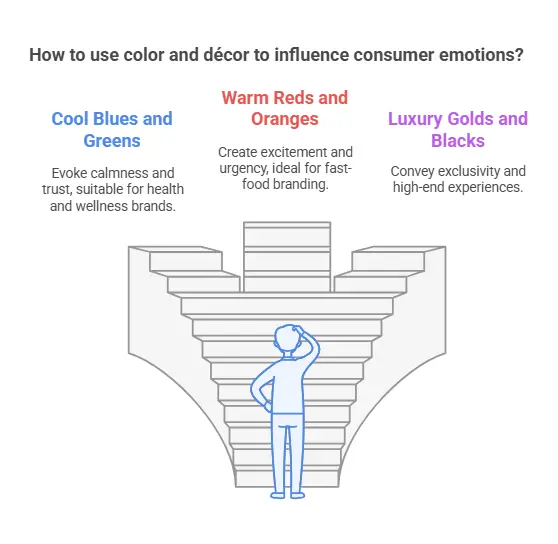
Language in Advertising
Words can be powerful primes. Using inclusive phrases like “together” and “community” can spark generosity in charitable contexts, while words like “exclusive” and “elite” may activate a status-driven mindset. Even describing a product in sensory terms can prime those sensations in the consumer’s mind—terms like “cool,” “refreshing,” or “soft and inviting” can lead to a more vivid, emotionally charged perception of your product.
In online ads or product descriptions, you can use subtle marketing tactics with carefully chosen adjectives. Words that hint at urgency (e.g., “limited time,” “last chance”) prime the fear of missing out (FOMO). In a broader sense, the way marketers frame a message—positive vs. negative, inclusive vs. exclusive—primes consumers on how to interpret the entire pitch.
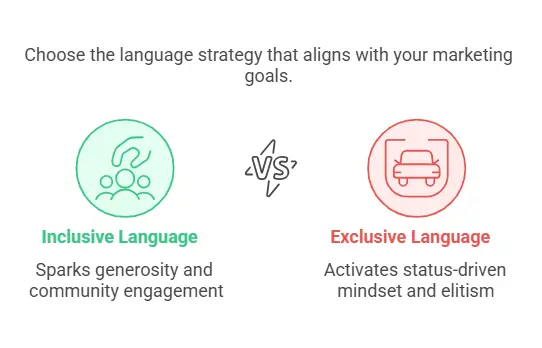
Product Placement and In-Store Layout
Priming in marketing doesn’t only revolve around abstract cues like color or music. Physical arrangements matter, too. Placing essentials at the back of a grocery store ensures consumers pass by many other items, priming them to notice deals and impulse products. At the aisle level, eye-level placement primes people to see certain brands or items first, increasing the chance of purchase. Complementary products (chips next to dip, cereal next to milk) can prime one to think, “Oh, I might need both.”
End-of-aisle displays often carry big signs that suggest promotions. These displays prime a “buy now” mindset, even if the items aren’t strictly discounted.
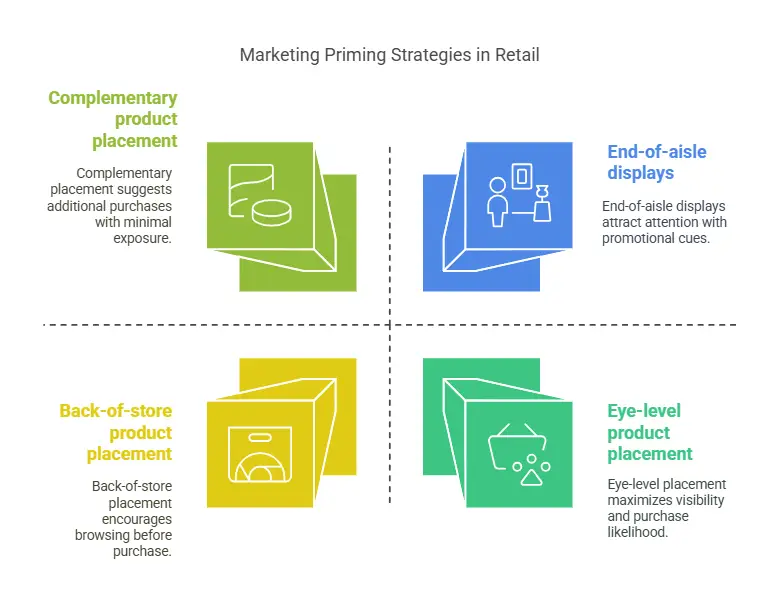
Imagery
Whether it’s a family gathered around a dinner table or a lone adventurer on a windswept beach, images prime viewers with emotions and associations. A single photo in a social media ad can make someone feel warmth, excitement, belonging, or curiosity—sensations that then transfer to how they view your brand.
Consider a car commercial: an ad featuring rugged mountains and daring exploration primes viewers for adventure and freedom. Another ad showing a stylish cityscape and high-end nightlife might prime the viewer to associate the same car with status and sophistication.
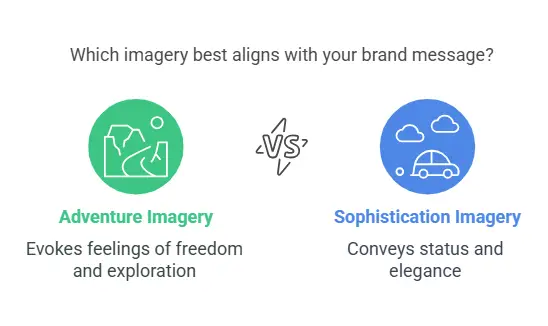
Web/UI Priming
Online platforms also rely heavily on subconscious priming. The choice of background image on a homepage can signal calmness or energy. Pre-checked options and defaults (like a subscription box already ticked) can nudge a user to accept the standard route. Labeling a product tier as “Most Popular Choice” might not be purely informational—it primes people to feel they’d be missing out if they don’t pick the crowd favorite.
If your business sells organic or eco-friendly items, using a nature-themed banner can subtly prime buyers to connect your products with sustainability. If you’re promoting technology solutions, a slick, futuristic visual environment can encourage a sense of innovation and trust in your modern approach.
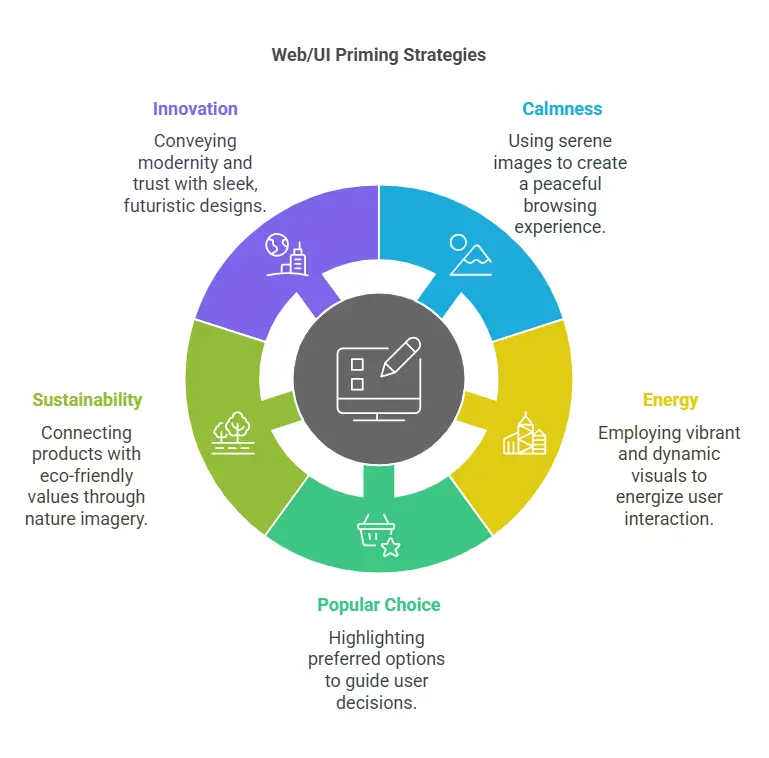
Using Priming in Your Marketing Strategy
Marketers regularly experiment with using priming in marketing to influence consumer behavior. Here are tangible ways to incorporate priming—across visual design, copy, and user experience—without crossing ethical boundaries.
Leverage the Right Visual Cues
The imagery, colors, and design elements that greet a consumer immediately create or reinforce certain moods. Decide how you want customers to feel: confident, relaxed, excited, or curious. Then choose your visuals accordingly. If your brand revolves around serenity and wellness, consider a nature-inspired palette, soft tones, and images of tranquil settings. If you’re aiming for urgency—like in a flash sale—use bold contrasts and suggest motion or limited-time prompts.
Best Practice Tips:
- Use A/B Testing: Compare designs (blue background vs. bright red banner) to see which primes the right behavior (longer browsing time, higher add-to-cart rates, more signups).
- Ensure Consistency: Every image, from product photos to website banners, should maintain a cohesive mood. Conflicting visuals can disrupt the prime, sending mixed signals to consumers.
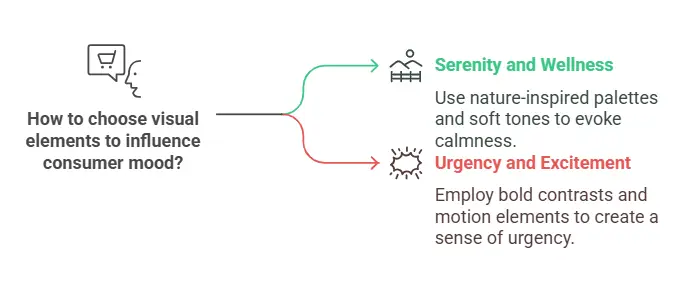
Shape Language and Framing
Copywriting is a powerful tool for subconscious cues marketing. The words you use can set a mental stage. If you’re marketing something related to safety or security (like antivirus software or insurance plans), start with protective terms: “safeguard,” “shield,” “secure.” This primes vigilance and underscores your product’s relevance.
If you want to tap into social cues, phrases like “join the community” or “thousands of satisfied customers” can prime a sense of belonging and social proof. If scarcity is key, words like “limited availability” or “only a few spots left” prime an urgent, FOMO-driven state.
Best Practice Tips:
- Highlight Benefits First: Frame the product in terms of its positive impact. Consumers who see immediate value are more receptive from the start.
- Inject Action Words: “Discover,” “unlock,” and “experience” can prime an active, participatory mindset.
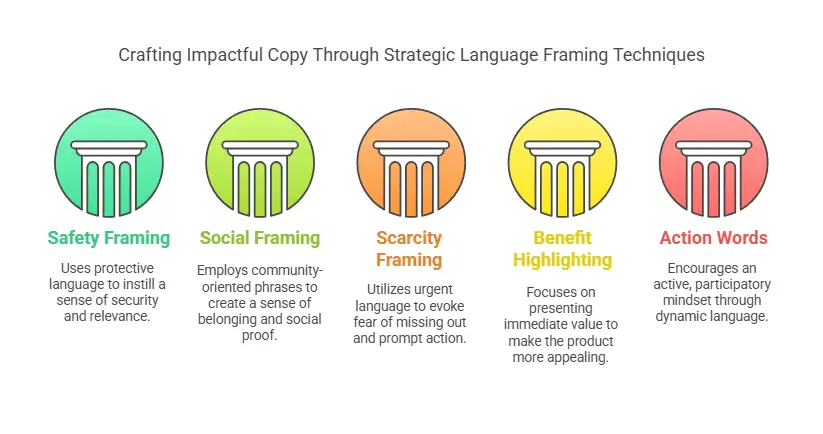
Consider Timing and Context
Timing can serve as a powerful natural prime. A coffee ad in the morning resonates with an already existing caffeine routine. A sports energy drink ad placed near workout articles or videos primes health-conscious readers to pay attention. Look for contextual or seasonal ties: a brand that sells cozy blankets can benefit by advertising during colder months or pairing with winter-themed content, priming the need for warmth and comfort.
Best Practice Tips:
- Behavioral Alignment: Align your ads with how people are already feeling or what they’re already doing at specific times or in specific contexts.
- Seasonal Cues: If you’re selling summer travel packages, images of beaches and sunshine can prime wanderlust effectively during the colder months.
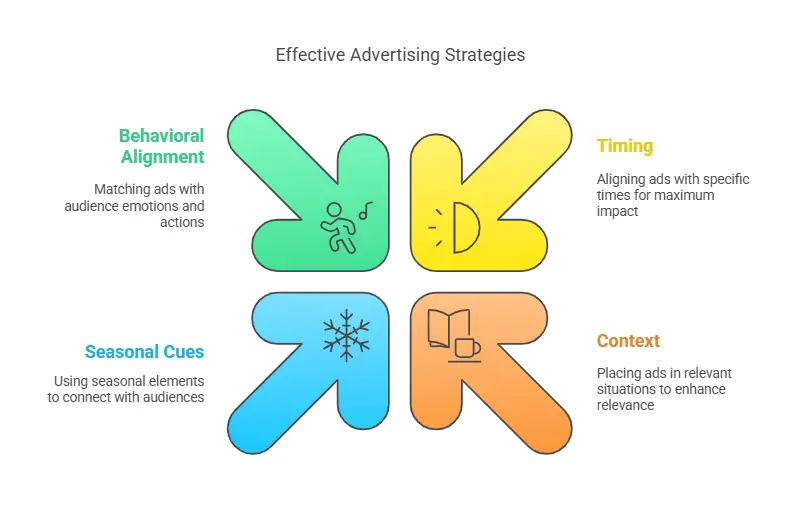
Enhance In-Store and Experiential Elements
For brick-and-mortar locations, ambient influence consumer behavior hinges on details like lighting, scent, and music selection. A calm and inviting spa likely uses gentle lighting, soothing scents, and soft melodies to prime relaxation. A trendy apparel store may use upbeat tunes, bright lighting, and bold window displays to prime excitement and spontaneity.
Scents are especially potent primes, as they can evoke memories or create new positive associations. A bakery pumping the scent of fresh bread can prime hunger and lead people to linger longer. Clothing stores using a signature fragrance can prime a sense of uniqueness and brand identity.
Best Practice Tips:
- Sensory Marketing Strategies: Complement your visuals with carefully chosen scents or auditory cues.
- Sync Multiple Senses: Combine color schemes, scents, and music themes that work together rather than clash.
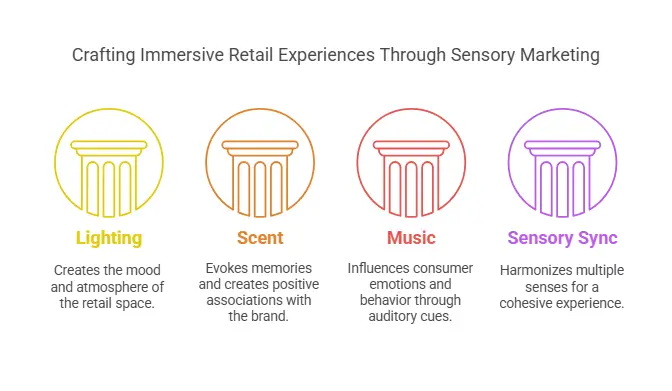
Subtle Nudges in Digital UX
Even a single button label can become a prime. “Start Your Journey” vs. “Sign Up Now” can provoke different reactions. If you run a subscription service, you might label your best plan “Recommended for Most Customers” to prime prospective buyers into feeling that plan is the standard choice.
Best Practice Tips:
- Add Microcopy: Short hints like “This helps us personalize your experience” can prime people to feel they’re getting something tailor-made and beneficial.
- Set Smart Defaults: If you want to encourage participation, pre-check boxes for optional features. Users can still opt out, but many will accept the default.
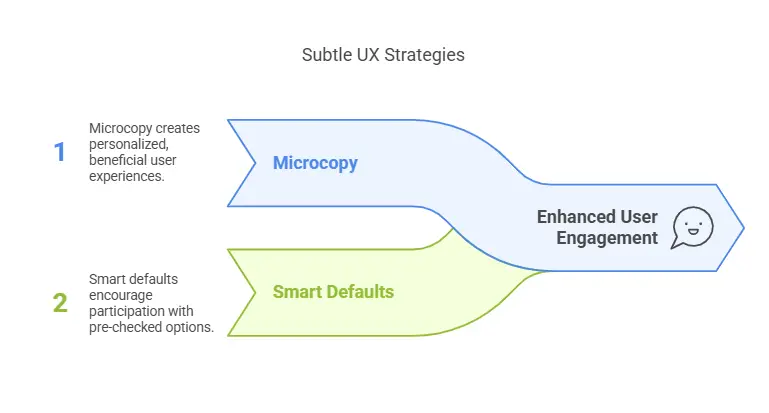
Test and Optimize Small Changes
Because priming effects can be subtle, marketers often discover them through experimentation. A/B testing different background images, color palettes, or even font choices can reveal surprising insights. If one version consistently results in higher conversions, it might be priming users more effectively toward a desired action.
Best Practice Tips:
- Keep Variables Controlled: Change only one small detail at a time to accurately measure its effect.
- Gather Feedback: While priming is subconscious, direct consumer feedback can still offer clues, such as comments about how a new design feels or how inviting a space is.
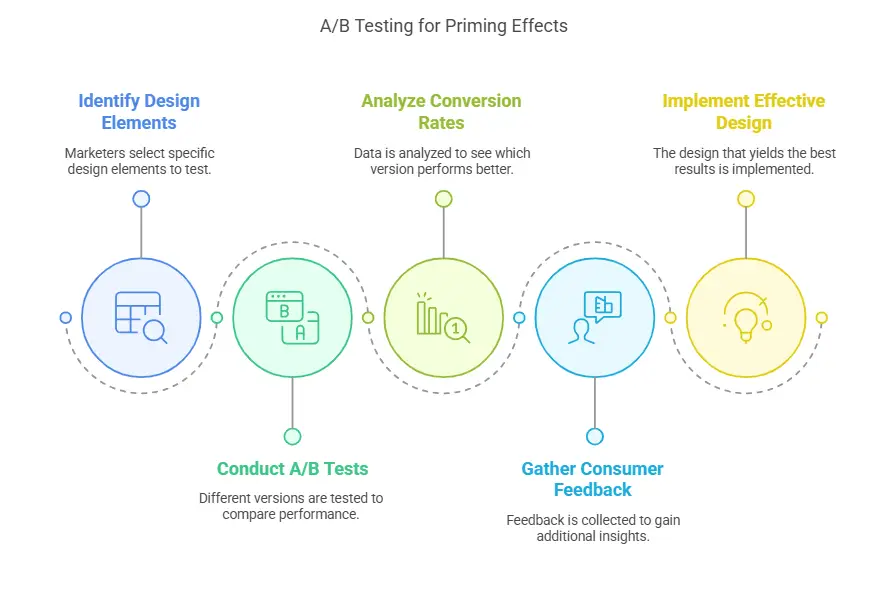
Stay Ethical and Aligned
Priming should enhance the consumer’s journey, not manipulate them into unwanted purchases or experiences. If you run a spa, priming relaxation with soft music and warm lighting adds authenticity to your service. If you have a limited-time offer, mention scarcity accurately—don’t fabricate false urgency.
Customers appreciate honesty, and consistent use of priming techniques can cultivate a strong brand perception. By aligning your primes with real benefits, you reinforce customer trust and keep them returning.
Conclusion
Priming and subconscious cues are some of the most potent tools in a marketer’s arsenal. Often invisible to the conscious mind, these cues set the context and mood that direct consumer choices. Slow music may lead shoppers to spend more time browsing a store’s aisles, while a strategic color scheme can make visitors on a website feel calm, confident, or excited. Language choices—words like “secure” or “community”—can prime viewers toward vigilance or social cooperation, ultimately shaping how they perceive products and brands.
Even though consumers might not say, “I bought this because the store played French music,” these subtle signals influence their overall mindset, paving the way for favorable decisions. For marketers, being aware of these cues and intentionally crafting them can create a more welcoming, persuasive environment. In essence, priming in marketing is about planting small seeds in a consumer’s subconscious so that, when decision time comes, those seeds blossom into preference and action.
It’s crucial, however, to maintain integrity. Align any subconscious nudges with genuine value, ensuring that if you prime relaxation or exclusivity, your product experience matches those expectations. Simple steps—like carefully choosing background images or the initial words on your website—can enhance your brand’s message and encourage desired outcomes.
By reviewing each touchpoint in your marketing funnel, from your website’s homepage design to the music in your retail space, you can identify and refine the subtle signals you send. This sort of conscious calibration often leads to more engaging brand experiences and increased conversion rates.
What subtle cue will you add to your marketing toolkit? Whether it’s a carefully chosen color palette, a rephrased headline, or a melodic background track, these little cues can quietly guide customers toward your offerings. Sometimes, the biggest differences come from the smallest, almost invisible changes.
In the end, effective priming is less about trickery and more about alignment—meeting your customers’ needs, emotions, and subconscious triggers with a thoughtful, well-curated environment. By steering the conversation and atmosphere in the right direction, you help consumers arrive at a choice that genuinely serves them while also supporting your business objectives.
Frequently Asked Questions
What is priming in marketing?
Priming in marketing involves exposing consumers to specific stimuli—such as words, images, or sounds—to subconsciously influence their subsequent behaviors and decisions. This technique leverages psychological associations to steer consumer perceptions and actions without their conscious awareness.
How does priming affect consumer behavior?
Priming subtly activates certain associations in consumers’ minds, making related concepts more accessible. For example, background music or color schemes can evoke specific emotions or memories, leading consumers to feel more inclined toward particular products or brands, thereby influencing their purchasing decisions.
Can you provide an example of priming in a retail environment?
In a retail setting, playing classical music can prime customers to perceive the environment as upscale, potentially leading them to purchase more premium products. Similarly, using citrus scents can evoke feelings of cleanliness, influencing customers to spend more time in the store.
What are some ethical considerations when using priming in marketing?
Marketers must use priming responsibly, ensuring that subconscious cues do not manipulate or deceive consumers. Ethical priming should enhance the customer experience without compromising autonomy, maintaining transparency, and aligning with the brand’s values to build trust and long-term relationships.
How can small businesses implement priming strategies effectively?
Small businesses can implement priming by carefully selecting elements like store layout, color schemes, music, and scent to create desired customer experiences. For instance, using specific colors can evoke certain emotions, and background music can set the ambiance, subtly influencing customer behavior and enhancing engagement.
Further reading
Einstein Marketer. “Priming in Marketing: The Psychological Hack You Need to Know.” Einstein Marketer. Accessed March 5, 2025. https://www.einsteinmarketer.com/priming-in-marketing/.
Marketing Society. “The Power of Priming (Part One).” The Marketing Society. Accessed March 5, 2025. https://www.marketingsociety.com/the-library/power-priming-part-one.
Moritz, Max. “The Priming Effect in Sales and Marketing.” MXMoritz. Accessed March 5, 2025. https://www.mxmoritz.com/article/the-priming-effect-in-sales-and-marketing.
Hype Insight. “Priming: A Powerful Yet Invisible Tool for Online Marketing.” Hype Insight. Accessed March 5, 2025. https://hypeinsight.com/priming-a-powerful-yet-invisible-tool-for-online-marketing/.
Ethics Unwrapped. “Priming.” YouTube video, 2:07. Uploaded November 20, 2014. Accessed March 5, 2025. https://www.youtube.com/watch?v=Z3edokCAZiA.
SciShow Psych. “How Your Brain Uses Priming to Make Decisions.” YouTube video, 5:33. Uploaded March 27, 2019. Accessed March 5, 2025. https://www.youtube.com/watch?v=L0-whJhTz3A.
Veritasium. “How Priming Affects Your Brain.” YouTube video, 10:01. Uploaded July 19, 2021. Accessed March 5, 2025. https://www.youtube.com/watch?v=OiARzwI80yY.







